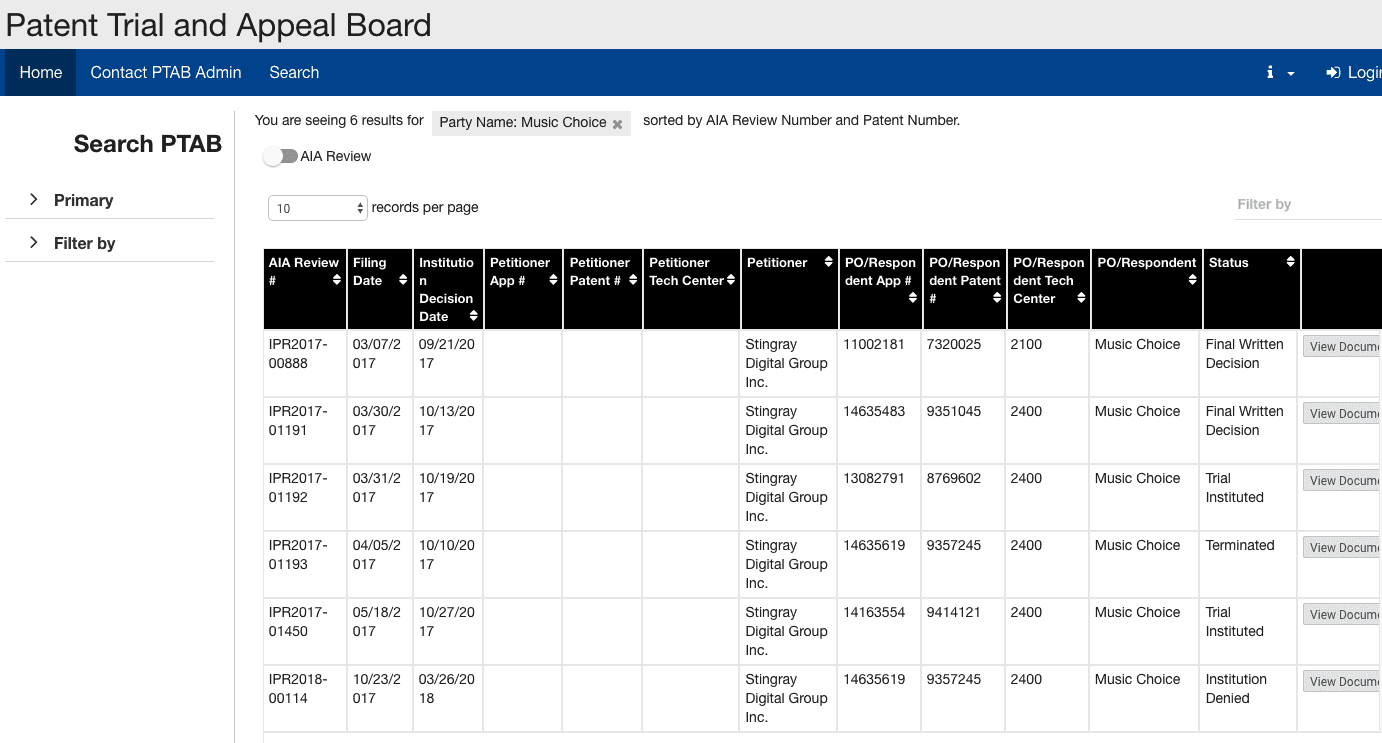
Late September and early October total of two judgments have been filed thus far by the Patent Trial and Appeal Board (PTAB) in the case against Music Choice’s patent. As indicated in the rulings for IPR2017-00888 and IPR2017-01191, partial axing fo the patents have been granted to Stingray or against Music Choice’s interest. Interesting findings that enforce the value of our cloud to cable TV patents.
The final written decisions are available herein:
As Law360 points out:
” The case split the PTAB panel, with each of the three judges filing opinions. The majority ruling by Judge Mitchell Weatherly held that eight of the patent’s 20 claims are invalid because Stingray showed that a person skilled in the art would be motivated to combine the earlier inventions to arrive at Music Choice’s invention, which includes both a playlist and on-demand playback. Source: https://www.law360.com/media/articles/1091845/ptab-partly-axes-music-choice-patent-in-row-with-rival “
This goes in accordance to the prediction made by myself back when this issue was discussed initially, specially in the article where I analyzed the acquisition of Music Choice by Stingray digital.
Infringement and Damages Model
As expected Music Choice should be more interested not so much on the “Video on Demand” revenues which is what these two patents cover, but more so in the patent covering the method and system for broadcasting to Cable TV which is the main source of revenues for both companies. The patent in dispute will be resolved this Friday October 19th, 2018, and the patent 8,769,062 as well as the original applications from 2001-08-28 which is claimed as priority date.
It is my opinion that a similar outcome may result from the PTAB panel.
Hence, what would the damages be for Music Choice? Well, I don’t have access to any information but what is found online, and in a letter from 2014, Music Choice was claimed to have 56M homes, or 57M listeners per month. Source: https://www.justice.gov/sites/default/files/atr/legacy/2014/08/18/307851.pdf ‘
In this document, Music Choice indicates that their Multi-Video Programming Distributors (MVPD) constitutes a main source of income for the company. Additionally, in a marketing material VOD distribution is said to have 72M subscribers as of Music Choice’s 2016 PDF :
http://corporate.musicchoice.com/files/2214/6228/4671/2016_Music_Choice_Media_Kit.pdf
In a similar filing, Music Choice makes a case with a rebuttal testimony by Gregory S. Crawford, PhD https://www.crb.gov/rate/16-CRB-0001-SR-PSSR-SDARSIII/rebuttals/2-21-17-music-choice.pdf
Hence, assuming a price point of let’s say 0.05c to 0.25c/subscriber and recalling what Mr. Boyko said in a prior-conference call, Music Choice should have revenues could be:
- 0.05c per subscriber @ 50M subs = $30M/year
- 0.25c per subscriber @ 50M subs = $150M/year
Assuming now that, Stingray has landed $8M/quarter with an increase of 102.2% or 23.5% o the total revenues, from the 4th Quarter Report available online
” … or the quarter, Canadian revenues decreased 2.6% to $13.6 million (41.3% of total revenues) due to decrease in non-recurring revenues related to digital signage, United States revenues increased 102.2% to $7.8 million (23.5% of total revenues), whereas revenues in Other Countries increased by 34.4% to $11.6 million (35.2% of total revenues). (CNBC source: https://www.cnbc.com/2018/06/07/globe-newswire-stingray-reports-fourth-quarter-2018-results.html) “
What this means is that somehow per year $32M/year o revenues were eroded from Music Choice’s pie, or since 2014 when the lawsuit was said to have had some issues with Stingray, then the total loss could be $32×4=$120M on damages. Which, it seems to have been the offering made by Stingray digital to Music Choice for a full acquisition.
The question is, what would be the forward revenues would be for a Georgia-Pacific model that a damages expert would have done for pricing moving forward and how Stingray Digital would have to pay for any future earnings to Music Choice. The information collected indices a 35% tax by Stingray on royalties and potentially another 20-30% which in turn would make operations in the United States at no profit or even at a loss.
Conclusion
It is very hard to compute a damages calculation, assuming that infringement takes place in the surviving claims of the patents in dispute. Hence, if damages were to be computed should be in the range of 8-9 digits with upside to the future, not including potential treble damages which could account for more money to be paid.
Alternatively, Cloud to Cable TV is the best technological platform for monetization with Cable TV and works using the most recent advancements in Cloud computing, Web technologies, and in combination with standard DVB Systems. A unified patented technology for Cable TV distribution!
Cloud to Cable TV

